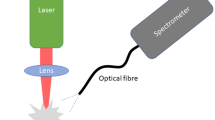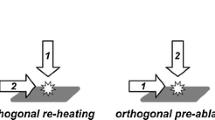Abstract
Laser Induced Breakdown Spectroscopy spectra of bacteria, with nanosecond and femtosecond ablation, are compared. High sensitivity for mineral trace detections, larger intensity from molecular bands and precise kinetic study are among benefits using short pulses.
Access this chapter
Tax calculation will be finalised at checkout
Purchases are for personal use only
Similar content being viewed by others
6. References
L.J. Radziemski, “From LASER to LIBS, the path of technology development”, Spectrochim. Acta, Part B 57, 1109–1113 (2002).
A.C. Samuel, F.C. Lucia, K.L. McNesby et al, “Laser-induced breakdown spectroscopy of bacterial spores, molds, pollens, and protein: initial studies of discrimination potential”, Appl. Opt. 42, 6205–6209 (2003).
K. Stelmaszczyk, P. Rohwetter, G. Mejean et al, “Long-distance remote laser-induced breakdown spectroscopy using filamentation in air”, Appl. Phys. Lett. 18, 3977 (2004).
B. Le Drogoff, J. Margot, M. Chaker et al, “Temporal characterization of femtosecond laser pulses induced plasma for spectrochemical analysis of aluminum alloys”, Spectrochim. Acta B 56, 987 (2001).
M. Baudelet, L. Guyon, J. Yu et al., “Femtosecond time resolved laser-induced breakdown spectroscopy for detection and identification of bacteria: a comparison to the nanosecond regime”, J. Appl. Phys., 99, 084701 (2006).
M. Baudelet, L. Guyon, J. Yu et al, “ Spectral signature of native CN bonds for bacterium detection and identification using femtosecond laser-induced breakdown spectroscopy”, Appl. Phys. Lett. 88, 063901 (2006).
Author information
Authors and Affiliations
Editor information
Editors and Affiliations
Rights and permissions
Copyright information
© 2007 Springer-Verlag Berlin Heidelberg
About this paper
Cite this paper
Guyon, L. et al. (2007). Laser-Induced Breakdown Spectroscopy analysis of Bacteria: What Femtosecond Lasers Make Possible. In: Corkum, P., Jonas, D.M., Miller, R.J.D., Weiner, A.M. (eds) Ultrafast Phenomena XV. Springer Series in Chemical Physics, vol 88. Springer, Berlin, Heidelberg. https://doi.org/10.1007/978-3-540-68781-8_62
Download citation
DOI: https://doi.org/10.1007/978-3-540-68781-8_62
Publisher Name: Springer, Berlin, Heidelberg
Print ISBN: 978-3-540-68779-5
Online ISBN: 978-3-540-68781-8
eBook Packages: Physics and AstronomyPhysics and Astronomy (R0)




